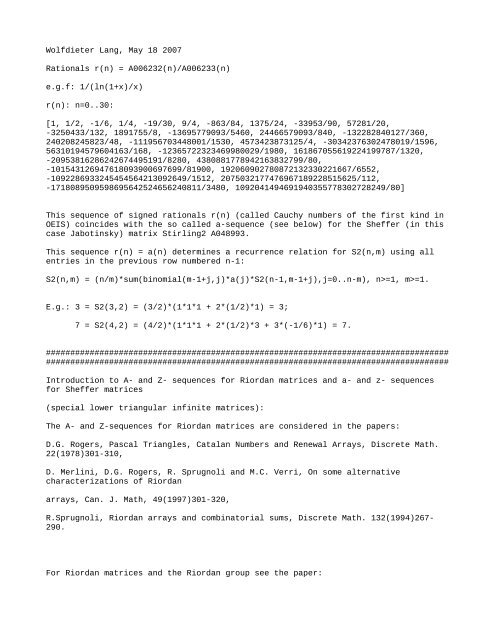Sheffer a
Sheffer a
Sheffer a
- No tags were found...
Create successful ePaper yourself
Turn your PDF publications into a flip-book with our unique Google optimized e-Paper software.
Wolfdieter Lang, May 18 2007Rationals r(n) = A006232(n)/A006233(n)e.g.f: 1/(ln(1+x)/x)r(n): n=0..30:[1, 1/2, -1/6, 1/4, -19/30, 9/4, -863/84, 1375/24, -33953/90, 57281/20,-3250433/132, 1891755/8, -13695779093/5460, 24466579093/840, -132282840127/360,240208245823/48, -111956703448001/1530, 4573423873125/4, -30342376302478019/1596,56310194579604163/168, -12365722323469980029/1980, 161867055619224199787/1320,-20953816286242674495191/8280, 4380881778942163832799/80,-101543126947618093900697699/81900, 192060902780872132330221667/6552,-1092286933245454564213092649/1512, 2075032177476967189228515625/112,-1718089509598695642524656240811/3480, 1092041494691940355778302728249/80]This sequence of signed rationals r(n) (called Cauchy numbers of the first kind inOEIS) coincides with the so called a-sequence (see below) for the <strong>Sheffer</strong> (in thiscase Jabotinsky) matrix Stirling2 A048993.This sequence r(n) = a(n) determines a recurrence relation for S2(n,m) using allentries in the previous row numbered n-1:S2(n,m) = (n/m)*sum(binomial(m-1+j,j)*a(j)*S2(n-1,m-1+j),j=0..n-m), n>=1, m>=1.E.g.: 3 = S2(3,2) = (3/2)*(1*1*1 + 2*(1/2)*1) = 3;7 = S2(4,2) = (4/2)*(1*1*1 + 2*(1/2)*3 + 3*(-1/6)*1) = 7.######################################################################################################################################################################Introduction to A- and Z- sequences for Riordan matrices and a- and z- sequencesfor <strong>Sheffer</strong> matrices(special lower triangular infinite matrices):The A- and Z-sequences for Riordan matrices are considered in the papers:D.G. Rogers, Pascal Triangles, Catalan Numbers and Renewal Arrays, Discrete Math.22(1978)301-310,D. Merlini, D.G. Rogers, R. Sprugnoli and M.C. Verri, On some alternativecharacterizations of Riordanarrays, Can. J. Math, 49(1997)301-320,R.Sprugnoli, Riordan arrays and combinatorial sums, Discrete Math. 132(1994)267-290.For Riordan matrices and the Riordan group see the paper:
L.V. Shapiro, S. Getu. W.-J.Woan, and L. Woodson, The Riordan Group, Discrete Appl.Math. 34(1991)229-239.##########################################################################################################Summary on A- and Z-sequences for Riordan matrices:A Riordan matrix R=(G,F) (in our notation) with an o.g.f. G(x) with G(0)=1 and aninvertible o.g.f.F(x)=x*Fhat(x) with Fhat(0)=1 is defined by its matrix elements R(n,m):=[(x^n)]G_m(x) with the o.g.f.for column nr. m>=0 given by G_m(x) = G(x)*F(x)^m = G(x)*(x*Fhat(x))^m.The o.g.f. of the row polynomials R(n,x):= sum(R(n,m)*x^m,m=0..n) isR(z,x):= sum(R(n,x)*(z^n)) = G(z)/(1-x*z*Fhat(z)).A Riordan matrix (coefficient matrix of the polynomials) is infinite lowertriangular: R(n,m)=0 if n=1; R(0,0):=1 (by convention).(b) For the columns m>=1:R(n,m) = sum(A(j)*R(n-1,m-1+j),j=0..n-m), n>=1, m>=1.The o.g.f.s for the Z- and A-sequences are obtained from G and F of the Riordanmatrix as follows:A(y):=sum(a(j)*y^j,j=0..infty) = Fhat(Finv(y))= y/Finv(y) with F(x)=x*Fhat(x) andFinv is the compositional inverse of F.Z(y):=sum(z(j)*y^j,j=0..infty) = (1- 1/G(Finv(y)))/Finv(y).Conversely, the o.g.f.s G and F of the Riordan matrix R are determined from theo.g.f.s A(y) and Z(y) as follows. First, Fhat(x)=A(F(x)) is used to either findf(x) directly from a(y) or a corollary to Lagrange's inversion theorem isemployed to give F_j := [x^j]F(x) = diff(A(t)^n,t$(n-1)|_{t=0}, n>=1 andF(0):=0.Then G(x) is found from G(x)=1/(1-Z(F(x))).The proof works for both directions. See the quoted references and the hints givenbelow for the <strong>Sheffer</strong> case.Example: Pascal's triangle A007318 R=P=(G(x)=1/(1-x),F(x)=x/(1-x)) with the A-sequence generated by
A(y)= Fhat(Finv(y)) = 1+y and the Z-sequence generated by Z(y)=1.This leads to the obvious recurrences for P(n,m) and P(n,0).######################################################################################################################################################################a- and z-sequences are the analoga of A- and Z-sequences for <strong>Sheffer</strong> matrices.For <strong>Sheffer</strong> matrices (polynomials) and the <strong>Sheffer</strong> group see the book:S. Roman, Umbral calculus, Academic Press, 1984.The notation (g=gR,f=fR) of this book translates as follows to our notation S=(g,f)for a <strong>Sheffer</strong> matrix:gR(t)= 1/g(finv(t))), fR(t)= finv(t), with the compositional inverse finv(t) off(x).Conversely, g(x)=1/gR(fRinv(x)), f(x)=fRinv(x), with the compositional inversefRinv(x) of fR(t).For the subgroup of the <strong>Sheffer</strong> group (1,f) called Jabotinsky subgroup, see thepaper:D. E. Knuth, Convolution polynomials, The Mathematica J., 2(1992)67-78.###################################################################################A <strong>Sheffer</strong> matrix S=(g,f) with e.g.f. g(x) with g(0):=1 and an invertible e.g.f.f(x) with f(0)=0is defined by its matrix elements S(n,m):=[(x^n)/n!] g_m(x) with the e.g.f. forcolumn No. m>=0 givenby g_m(x)=g(x)(f(x)^m/m!).The e.g.f. of the row polynomials s(n,x):=sum(S(n,m)*x^m,m=0..n) iss(z,x):= sum(s(n,x)*(z^n)/n!) = g(z)*exp(x*f(z)).A <strong>Sheffer</strong> matrix (coefficient matrix of the polynomials) is infinite lowertriangular: S(n,m)=0 if n=1; S(0,0):=1 (by convention).(b) For the columns m>=1:
S(n,m) = (n/m)*sum( binomial(m-1+j,m-1)*a(j)*S(n-1,m-1+j),j=0..n-m), n>=1, m>=1.The e.g.f.s for the z- and a-sequences are obtained from g and f of the <strong>Sheffer</strong>matrix as follows:a(y):=sum(a(j)*(y^j)/j!,j=0..infty) = fhat(finv(y)) = y/finv(y) with f(x)=x*fhat(x)and finv is thecompositional inverse of f.z(y):=sum(z(j)*(y^j)/j!,j=0..infty) = (1- 1/g(finv(y)))/finv(y).Conversely, the e.g.f.s g and f of the <strong>Sheffer</strong> matrix S are determined from thee.g.f.s a(y) and z(y) asfollows. First, f(x)=x*a(f(x)) is used to either find directly f(x) from a(y) or acorollary to Lagrange's inversion theorem is employed to givef_j := [(x^j)/j!]f(x) = diff(a(t)^n,t$(n-1)|_{t=0}, n>=1 and f(0):=0.Then g(x)=1/(1-z(f(x))).The proof works for both directions.(a) Insert the recurrence for S(n,0) into g(x)=1 + sum(S(n,0)*(x^n)/n!,n=1..infty),interchange the sums (formal power series here), building the e.g.f. g_j(x) and useits <strong>Sheffer</strong> structure. This produces g(x)= 1+x*g(x)z(f(x)). From this one findsg(x)=1/(1-x*z(f(x))) orz(y) = (1- 1/g(finv(y)))/finv(y).This argument can be reversed.(b) Insert the recurrence for S(n,m) intog_m(x)= 0 + sum(S(n,m)*(x^n)/n! ,n=1..infty),interchange the sums (formal power series), finding the e.g.f. g_{m-1+j}(x) anduse its <strong>Sheffer</strong> structure. The factorials are rearranged to produceg_m(x)*(x*a(f(x)))/f(x). This shows thata(f(x))=fhat(x) with fhat(x)=f(x)/x.This argument can also be reversed.###################################################################################Note: This recurrences (a) and (b) are not always the simplest one for S(n,m).E.g. Stirling2 = A048993, which has z(y)=0 from g(x)=1 (this is what one expectsfor the first m=0 column) but finv(y)=ln(1+y) leading to a(y)=1/(ln(1+y)/y), whichgenerates the sequence A006232(n)/A006233(n). Hence all entries of the previousrow starting with S2(n-1,m-1) are needed for S2(n,m).The usual recurrence used for S2(n,m) needs only to terms of the previous row. Seethe recurrence for <strong>Sheffer</strong> polynomials given as next item.###################################################################################
There is also a recurrence for the row polynomials s(n,x):=sum(S(n,m)*x^m,m=0..n)for every <strong>Sheffer</strong> matrix S=(g,f). In the general case it uses formal seriesexpansion employing a corollary of Legendre's inversion theorem.s(n,x) = (x+(ln(g(finv(t))))')/finv'(t)|_{t -> d_x} s(n-1,x), n>=1; s(0,x)=1.Here ' denotes derivative w.r.t. t, finv is the compositional inverse of f andd_x=d/dx is the derivative w.r.t. x (powers of t should to be replaced by powersof d_x).This formula is the rewritten version of S. Roman's book (op. cit.) p. 50,Corollary.The proof uses the fact that finv(d_x) s(z,x) =finv(f(z)) s(z,x) = z s(z,x) withthe e.g.f. s(z,x) for therow polynomials given above, and d_x=d/dx is the derivative w.r.t. x. This followsfrom del_x^k s(z,x) = f(z)^k s(z,x) together with del_z s(z,x) = ( ln(g(z))'+x*f'(z))*s(z,x) with ' denoting differentiation w.r.t. z, and del_x, resp. del_zstands for the partial derivative w.r.t. x, resp. z.##################################################################################In the Stirling2 case, with finv(t)=ln(1+t) and g(t)=1 this recurrence becomesS2(n,x) =x*(1 + d_x)*S2(n-1,x), n>=1, S2(0,x)=1, with the row polynomialsS2(n,x):=sum(A048993(n,m),m=0..n).Comparing coefficients of powers of x leads to the known three term recurrenceS2(n,m) = S2(n-1,m-1) + m*S2(n-1,m). The inputs are: S(0,0)=1, S(n,-1)=0 andS(n,m)=0 if n



